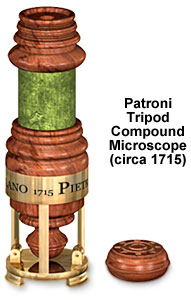Patroni Tripod Compound Microscope
This brass, wood, and green vellum compound microscope, crafted by Pietro Patroni, recalls the style promoted by fellow Italian instrument maker Joseph Campani during the seventeenth century, but prefigures the similar British Edmund Culpeper microscopes that were first designed around 1725.

Focus of the instrument is accomplished by sliding the wood and vellum body tube in and out of the wooden cylinder or barrel that supports a biconvex objective lens. Adjacent to the microscope is a wooden cap used to protect the biconvex eyepiece when not in use. The instrument features three brass pillars that attach to a brass, circular stage, which is supported by three short feet. Unlike later Culpeper-style models, however, the Patroni cylinder microscope does not have a mirror or condenser for illuminating specimens. The brass microscope stand is engraved "Pietro Patroni in Milano 1715" around the brass support that holds the wood and vellum microscope body. The original instrument remains part of the permanent collection at the National Museum of the History of Science and Medicine in Leyden, Netherlands, though the source that inspired the illustration and description featured here is Maria Rooseboom's book Microscopium.
BACK TO EIGHTEENTH CENTURY MICROSCOPES
